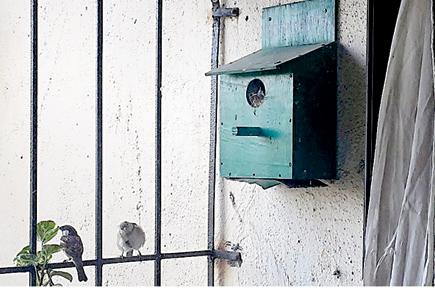As toddlers, the house sparrow tops the list of birds we were introduced to in our childhood

It is easy to create a breeding space for house sparrows by setting up a feeding plate at a balcony
 As toddlers, the house sparrow tops the list of birds we were introduced to in our childhood. Our memories of the bird include the time we refused to finish our food and mothers and grannies warned us about the little sparrow that would eat the morsel.
As toddlers, the house sparrow tops the list of birds we were introduced to in our childhood. Our memories of the bird include the time we refused to finish our food and mothers and grannies warned us about the little sparrow that would eat the morsel.
House sparrows are known by many local names — Chimni/Chiu (Marathi), Guraiya (Hindi), Chakli (Gujarati) and are associated with fertility, familiarity, agriculture and civilisation. Although house sparrows are originally from the Middle East and went on to occupy parts of Eurasia and North Africa, today they inhabit suburban regions. House sparrows avoid dense rainforests, extremely cold and warm deserts and the Polar Regions — in fact, they thrive in the saline and dry areas of our country. Over the years, they have been accidentally introduced into the North and South Americas, South and Western Africa, Australia, New Zealand and many other islands, giving them the distinction of being the most widely distributed 'wild bird' in the world.
ADVERTISEMENT

It is easy to create a breeding space for house sparrows by setting up a feeding plate at a balcony
Dr Salim Ali's autobiography 'The fall of a sparrow' made him world famous as an ornithologist. However, the common man is familiar with sparrows via their courtship dance in sports fields and near nesting spots. We know they are around when we spot grass and cotton stuffed into air conditioners, street lamps, electric boxes, broken pipes, in tiled roofs and tree holes to make a comfortable nest. Alternatively, those living near Bhavan's College (Andheri West) or Kharghar, IIT Campus or Malabar Hills, may have heard and seen large chirpy flocks of sparrows, roosting on bamboo clumps or in thorny bushes, around dusk.
House sparrows — largely believed to feed on seed, berry and grain due to the shape of their beak — are actually equally insectivorous and need a good population of insects during their nesting period (which is from March to April and September to October) to feed their young. Thus, unknowingly, they play a very important role in controlling the population of insects such as cockroaches, termites, ants, mosquitoes and flies. Besides adaptability in nesting and an omnivorous diet, sparrows also thrive around humans, as they feast on cooked human food as well.
Domesticated cats and Sparrowhawks are known to be among the largest predators responsible for the decline of sparrows across the world. Snakes, owls, kites, falcons, squirrels and dogs are other common predators.
The changing facade of buildings with flat glasses and pigeon meshes has rendered these useful sparrows homeless. Shockingly, these highly gregarious birds remain monogamous till they lose a mate. They, then, easily take another partner from among the helping partners in the flock. There are confusing and contradictory reports about how the population of house sparrows is on the decline in urban, rural and wild areas. However, without a good historical baseline to ascertain the assumptions, these statements will remain, at the best, speculative. Research in developed countries has shown that in many parts, over 68-90 per cent of the population has died out, though the overall distributional range has increased at around 230km/year. Electromagnetic radiation (mobile towers), diseases and loss of breeding spaces due to changing urban housing design are the most commonly reported causes of their decline.
However, it is easy to create a breeding and roosting space for house sparrows. Set up a feeding plate and drinking bowl in the balcony/window sill and place leftover cooked rice, fruits and grains near a bird nest box made from wood or particle board. Besides that, some climbers, grasses and flowering plants also become an inviting space for male and female sparrows to come and dance around.
Lastly, controlling the number of stray cats in your vicinity and creating terrace gardens are ideal solutions to ensure that house sparrows continue to chirp 'wake-up calls' for years to come.
Anand Pendharkar is an ecologist and the founder of SPROUTS, an outdoors and eco-tourism company and SPROUTS Environment Trust, an NGO which works with youth and underprivileged groups and aims to provide a sustainable environment for all
 Subscribe today by clicking the link and stay updated with the latest news!" Click here!
Subscribe today by clicking the link and stay updated with the latest news!" Click here!







